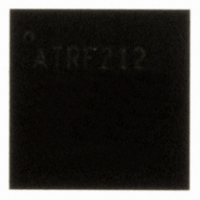AT86RF212-ZU Atmel, AT86RF212-ZU Datasheet - Page 104

AT86RF212-ZU
Manufacturer Part Number
AT86RF212-ZU
Description
IC TXRX ZIGBE/802.15.4/ISM 32QFN
Manufacturer
Atmel
Datasheet
1.AT86RF212-ZU.pdf
(172 pages)
Specifications of AT86RF212-ZU
Frequency
700MHz, 800MHz, 900MHz
Data Rate - Maximum
250kbps
Modulation Or Protocol
802.15.4 Zigbee, 6LoWPAN, ISM
Applications
ISM, ZigBee™
Power - Output
10dBm
Sensitivity
-110dBm
Voltage - Supply
1.8 V ~ 3.6 V
Current - Receiving
9.2mA
Current - Transmitting
25mA
Data Interface
PCB, Surface Mount
Antenna Connector
PCB, Surface Mount
Operating Temperature
-40°C ~ 85°C
Package / Case
32-VQFN Exposed Pad, 32-HVQFN, 32-SQFN, 32-DHVQFN
Number Of Receivers
1
Number Of Transmitters
1
Wireless Frequency
769 MHz to 935 MHz
Interface Type
SPI
Noise Figure
7 dB
Output Power
21 dB
Operating Supply Voltage
1.8 V, 3 V
Maximum Operating Temperature
+ 85 C
Mounting Style
SMD/SMT
Maximum Supply Current
25 mA
Minimum Operating Temperature
- 40 C
Modulation
OQPSK
Protocol Supported
802.15.4
Operating Temperature (min)
-40C
Operating Temperature (max)
85C
Operating Temperature Classification
Industrial
Lead Free Status / RoHS Status
Lead free / RoHS Compliant
Memory Size
-
Lead Free Status / Rohs Status
Lead free / RoHS Compliant
Available stocks
Company
Part Number
Manufacturer
Quantity
Price
Company:
Part Number:
AT86RF212-ZU
Manufacturer:
HITTITE
Quantity:
5 000
Part Number:
AT86RF212-ZU
Manufacturer:
ATMEL/爱特梅尔
Quantity:
20 000
Part Number:
AT86RF212-ZUR
Manufacturer:
MICROCHIP/微芯
Quantity:
20 000
7.3.4 TX Output Power
7.3.5 TX Power Ramping
Figure 7-9. TX Power Ramping Example (O-QPSK 250 kbit/s Mode)
104
AT86RF212
Figure 7-4 to Figure 7-8 illustrate typical spectra of the transmitted signals of the
AT86RF212 and do not claim any limits.
Refer to the local authority bodies (FCC, ETSI, etc.) for further details about definition of
power spectral density masks, definition of spurious emission, allowed modulation
bandwidth, transmit power, and its limits.
The maximum output power of the transmitter is typically 5 dBm in normal mode and 10
dBm in boost mode. The TX output power can be set via register bits TX_PWR (register
0x05, PHY_TX_PWR). The output power of the transmitter can be controlled down to
-11 dBm dB with 1 dB resolution.
To meet the spectral requirements of the European and Chinese bands, it is necessary
to limit the TX power by appropriate setting of TX_PWR, GC_PA (register 0x05,
PHY_TX_PWR), and GC_TX_OFFS (register 0x16, TX_CTRL_0). See Table 7-15 and
Table 7-16 for recommended values.
To optimize the output power spectral density (PSD), individual transmitter blocks are
enabled sequentially. A transmit action is started by either the rising edge of pin
SLP_TR or the command TX_START in register 0x02. One symbol period later the data
transmission begins. During this time period, the PLL settles to the frequency used for
transmission. The PA is enabled prior to the data transmission start. This PA lead time
can be adjusted with the value PA_LT in register 0x16 (RF_CTRL_0). The PA is always
enabled at the lowest gain value corresponding to GC_PA = 0. Then the PA gain is
increased automatically to the value set by GC_PA in register 0x16 (RF_CTRL_0). After
transmission is completed, TX power ramping down is performed in an inverse order.
The control signals associated with TX power ramping are shown in Figure 7-9. In this
example, the transmission is initiated with the rising edge of pin 11 (SLP_TR). The radio
transceiver state changes from PLL_ON to BUSY_TX.
Using an external RF front-end (refer to section 9.4), it may be required to adjust the
startup time of the external PA relative to the internal building blocks to optimize the
overall PSD. This can be achieved using register bits PA_LT (register 0x16,
RF_CTRL_0).
8168C-MCU Wireless-02/10













